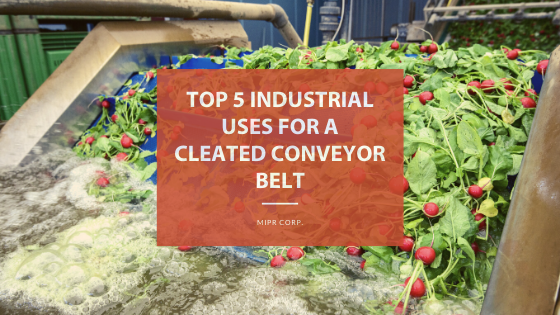
If you’re in the business of getting the job done quickly and efficiently – and let’s be honest, who isn’t – then you’re going to want to look into cleated conveyor belts.
Cleated conveyor belts are especially advantageous when they’re used in industries like agriculture, mining, logistics or food and beverage. By improving grip with intuitively designed cleats, operators can create separation on the line, navigate inclines and improve the accuracy and performance of the belt.
Narrowing down the top uses for cleated conveyors isn’t easy, but you can’t go wrong incorporating them in the following industries:
1. Agriculture Cleated Conveyor Belts
Whether it’s potatoes, blueberries or any other types of crops, agriculture conveyors feature prominently in the farming process from the soil surface to up into the truck. Anyone in the industry knows that from harvesting to processing, life is much easier when machinery is involved.

Cleated conveyor belts are ideal for types of work like agriculture, where the terrain and the materials themselves could pose issues due to steep inclines or the need to separate into batches. Incorporating them at various points in the process can improve productivity – which only benefits the company in the long run, of course.
Similarly, leveraging a cleated conveyor belt with steep inclines can give processing plants that mechanical advantage they’ve been searching for. Companies can opt for more vertical designs, which saves valuable space on the floor and reduces the capital cost on the equipment.
2. Food Handling Cleated Conveyor Belts
There are a lot of different layers to the food and beverage industry, with few more important than the creation and preparation of food. Many of the products can be difficult to move efficiently at scale, even with state-of-the-art machinery.
Don’t forget that many foods are temperature sensitive and could lose their value under the wrong circumstances, like dried hops. An inability to manage temperatures effectively could have far-reaching financial effects. The worst case scenario is coming to fruition more often, with the industry now seeing food recalls rise 10 percent over the last five years, according to the Public Interest Research Group. Even one incident could devastate the bottom line and a company’s reputation.
 Using a cleated conveyor belt that’s uniquely built for the type of food it’ll handle keeps operations running smoothly with foodstuff kept neatly in check and at the perfect temperature point during operation.
Using a cleated conveyor belt that’s uniquely built for the type of food it’ll handle keeps operations running smoothly with foodstuff kept neatly in check and at the perfect temperature point during operation.
3. Mining and Excavation Cleated Conveyor Belts
Sand, gravel, limestone and other minerals are difficult to move through an excavation site or work site, given their often rugged layout. If walking through an area proves difficult, transporting sediment in or out of the area will only be more taxing.

By using a cleated conveyor belt, companies can significantly cut down on lost materials and better automate traditionally manual aspects of operation. Incorporating this technology can considerably improve worksite productivity, especially if it was non-existent beforehand.
At the end of the day, all materials respond differently to being handled by each design. Finding out whether a closed chevron or a U-shape design works better could make all the difference in improving the belt’s efficiency.
4. Logistics and Warehousing Cleated Conveyor Belts
The rise of eCommerce has helped logistics flourish on a massive scale, with warehouses fulfilling a key role in the success of the complex distribution that comes with an industry worth $1.6 trillion in 2018.
Automation is at the forefront of it all, with machinery playing a pivotal role in helping to achieve tight delivery deadlines. The equipment at the frontlines of moving materials and products is a critical investment, with roughly one in every 10 warehouses in the U.S. using machines that completely automate the process, according to Westernacher, a global consulting firm.
A single jam or lost parcel could bear significant costs for a company. Cleated conveyor belts ensure that items stay on track for correct distribution, maintaining peak efficiency and sustaining high productivity in light of increasing workloads.
5. Recycling Cleated Conveyor Belts
Sustainability has come to the forefront of consumers’ minds and nowhere is this being felt more than at recycling plants, with the US recycling rate up to 35 percent, according to the EPA. That’s roughly 87 million tons of material being recycled each year; or nearly 15 Great Pyramids of Giza – one of the seven Wonders of the World.
These operations deal with a massive amount of recyclables and attempting to process it all without the right equipment can lead to significant operational bottlenecks.
With a large volume of inconsistently sized materials that may have different weights, cleated conveyor belts help recycling plants keep materials in tow and operations humming along as scheduled. The custom-designed belts are a boon to efficiency, ensuring a far greater amount of recyclable material gets to its intended destination without issue thanks to uniquely fitted designs
Retrofitting equipment with patterns that are targeted to transport specific materials can improve the efficiency of legacy machinery, helping companies stave off costly capital investments.
Interested in finding out whether a cleated conveyor belt can help you in your line of work? We can send you a sample of the model you have in mind on the same day you contact us




